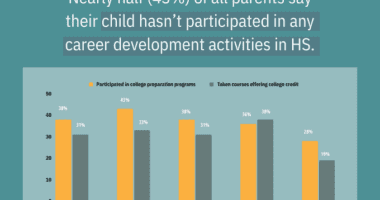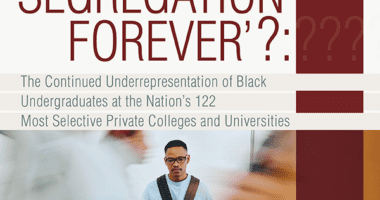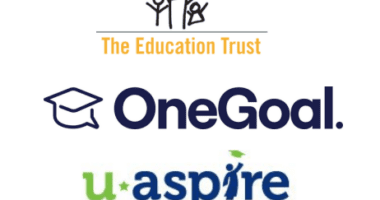As Districts Face Teacher Shortages, Black and Latino Students Are More Likely to Have Novice Teachers Than Their White Peers
New research by The Education Trust looks at the unique disparities Black and Latino students face in access to experienced teachers
WASHINGTON— When even one teacher leaves the classroom, the consequences can be huge for a school and the students it serves. With the global health pandemic increasing burdens placed on teachers, the projected number of retirements and pandemic- and burnout-related exits from the teaching field is expected to increase, exacerbating an already urgent need to hire and train new educators. Getting Black students Better Access to Non-Novice Teachers and Getting Latino students Better Access to Non-Novice Teachers from The Education Trust reveal that Black and Latino students are already more likely than other groups of students to be in classrooms with teachers who are in their first years of teaching. As our nation’s schools continue to face teacher shortages, these disparities could become even more prevalent.
“There will always be new teachers entering the profession, and anyone entering a new profession faces a learning curve,” said Sarah Mehrotra, P-12 research and policy analyst with The Education Trust and the lead author of the reports. “As school leaders and districts hire new educators, they can take proactive steps to ensure that Black and Latino students do not face disparities in access to non-novice teachers as well as better prepare and support new educators for the challenges that they will face as they enter the teaching profession.”
“Ultimately, teachers are the No.1 predictor of student success inside the classroom, estimated to have two to three times the effect of any other in-school factor,” Mehrotra continued. “Our new study shows that Black students and Latino students have less access to teachers who have had time to master their craft. As the nation faces severe teaching shortages, we ask districts across the nation to review their hiring as well as their teacher induction and support practices to better support new educators entering the profession to ensure Black and Latino students receive instruction from experienced and supported educators.”
In the reports, Ed Trust looks separately at inequitable access to experienced teachers for Black and Latino students across the country and whether inequalities are due to varying levels of teacher experience between the districts in a state or within individual districts. Specifically, Ed Trust analyzed data from the U.S. Department of Education’s 2017-18 Civil Rights Data Collection, or CRDC, to compare percentages of first year, novice (first and second year), and uncertified teachers in schools serving the most and fewest Black and Latino students.
Ed Trust finds:
- Black students are more likely to attend schools that have high percentages of novice teachers in almost every state across the country. For example:
- In Mississippi, about 25% of Black students attend schools with high percentages of novice teachers, compared to 7% of non-Black students.
- In Maryland, nearly 40% of Black students attend schools with high percentages of novice teachers, compared to about 20% of non-Black students.
- And in eight states (Arizona, Florida, Kentucky, Louisiana, Maryland, Oklahoma, Pennsylvania, and Texas), 30% or more of Black students attend schools with high percentages (greater than 20%) of novice teachers.
- Not only do Black students have more novice teachers, but they also have more first-year teachers. On nationwide average, schools serving the highest percentages of Black students have 8% first-year teachers; whereas, schools serving the lowest percentages of Black students have 5% first-year teachers. In 25% of states, schools serving the greatest percentages of Black students have at least twice the percentage of first-year teachers as schools serving the fewest.
- In Louisiana and Mississippi, for example, schools serving the greatest percentages of Black students have almost three times the percentage of first-year teachers as schools serving the fewest.
Similar disparities impact Latino students:
- In more than half the states, Latino students have more novice teachers than their peers. For example,
- In Rhode Island, there are three times as many novice teachers in schools serving the largest percentages of Latino students as schools serving the smallest percentages of Latino students.
- In New York and Connecticut, schools serving the most Latino students have about twice the percentage of novice teachers as schools serving the fewest
- In 32 states, Latino students also have more first-year teachers.
- New York schools that serve the most Latino students have 8% first-year teachers compared to 4% at schools serving the fewest
- In three states — Rhode Island, Pennsylvania, and Washington — Latino students are 2 to 3 times more likely to attend schools that have high percentages of novice teachers
- In eight states, more than 25% of Latino students attend schools with high percentages of novice teachers
“Every child deserves to have the highest-quality teacher in front of them as we know the experience and abilities of a teacher are the absolute keys to unlocking a child’s potential,” said T. Lamar Goree, Ph.D., Superintendent, Caddo Parish Public Schools in Louisiana. “In addition to having the highest quality teachers, districts should prioritize ensuring students have professionals who look like them across schools and grade configurations. It is difficult for a child to imagine what they can achieve when they cannot see that vision in front of them with a professional role model.”
Ed Trust reports, Getting Black students Better Access to Non-Novice Teachers and Getting Latino students Better Access to Non-Novice Teachers, make the case that access to experienced educators for Black and Latino students vary greatly across and within states. Ed Trust asserts that district and state leaders can take actions that move beyond highlighting these inequities to proactively address them. The advocacy organization lays out several recommendations for states and districts, including:
- Invest in strengthening school leaders in high-need districts and schools.
- Invest in evidence-based Grow Your Own and high-quality residency programs.
- Pay teachers more to work in high-need districts, schools, and subjects.
- Support high-need districts in hiring early.
- Provide teachers, especially novice teachers, with mentoring, support, and other professional learning opportunities.
- Develop networks of district leaders to problem-solve together.
“Black and Latino students and students from low-income backgrounds were underserved prior to the pandemic, and recent studies show an alarming increase in the opportunity gaps these students face,” said Denise Forte, interim CEO of The Education Trust. “Having a teacher with more than just a year or two of teaching experience in a student’s classroom matters. We call on state and district leaders to take immediate steps to end these disparities.”
To download the reports, visit:
- Getting Black students Better Access to Non-Novice Teachers
- Getting Latino students Better Access to Non-Novice Teachers
###









